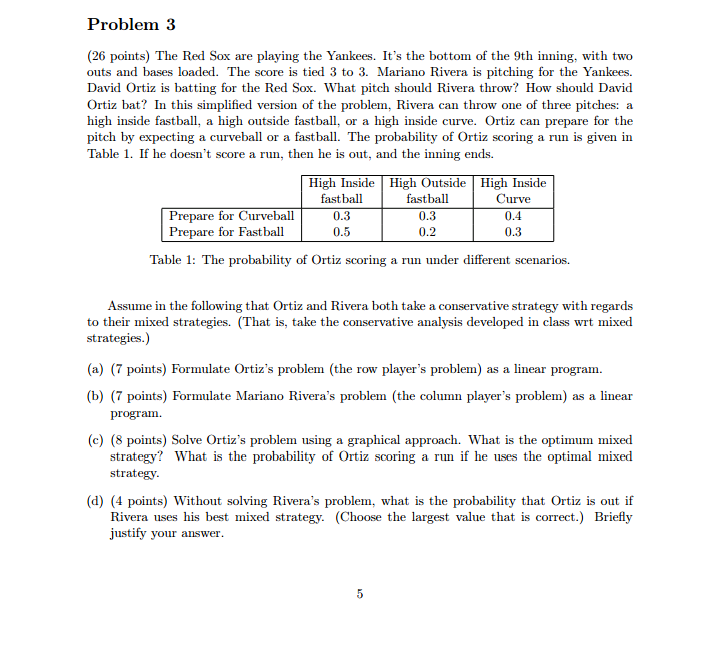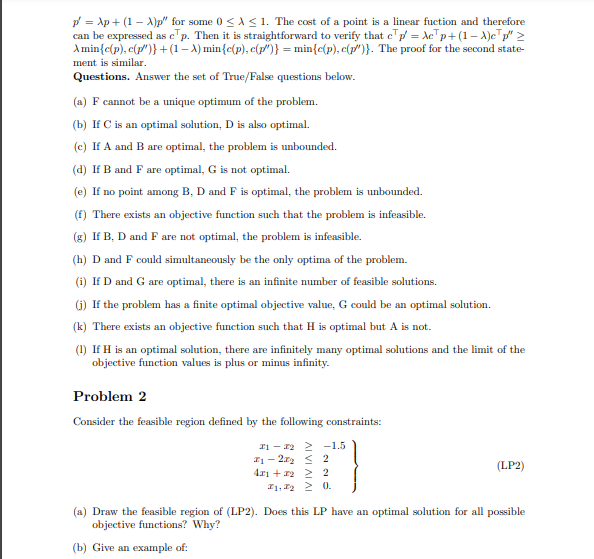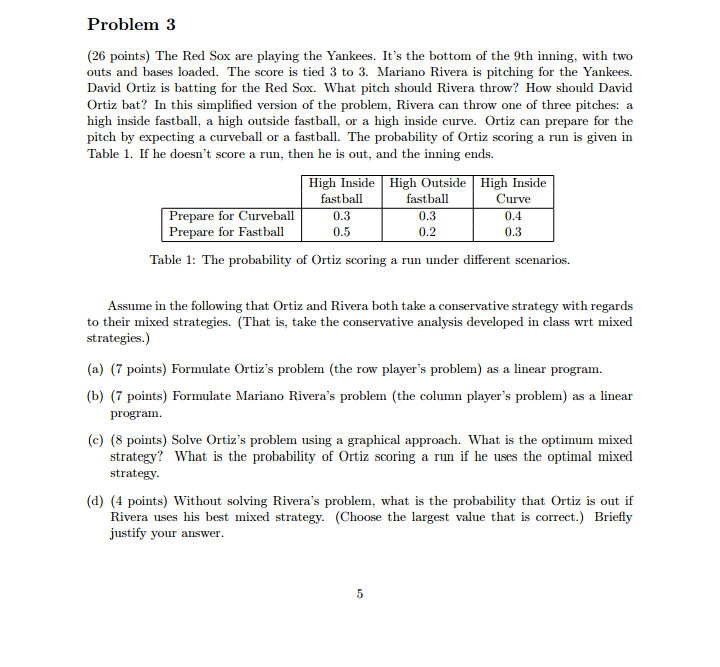ECO987Q3 1. (10) Briey discuss the following statements (keep your answers short and concise): (a) The consumption-based capital asset pricing model is inconsistent with high


ECO987Q3
1. (10) Briey discuss the following statements (keep your answers short and concise): (a) The consumption-based capital asset pricing model is inconsistent with high volatility of stock prices. (b) In standard real business cycle models, the MPK is highly procyclical. This implies that interest rates (i.e. real) will be as well. 2. (20) An economy is populated by identical, innitely-lived agents (there is no population growth) that maximize the present discounted value of lifetime utility given by X1 t=0 t ln ct ; 2 (0; 1) where ct denotes consumption. Output is produced via a standard Cobb-Douglas production function: yt = k t where kt denotes the beginning of period capital stock. (Implicitly it is assumed that labor supply is inelastically supplied by households to rms and that the labor input has been normalized to unity. Hence the labor market is ignored in this analysis.) In addition to consumption, households choose investment. This produces next periods capital stock using the following production function: kt+1 = k t t i 1t t where t denotes a stochastic depreciation factor. It is assumed that this shock, the only source of uncertainty in the economy, is an i:i:d: random variable. Given this environment, do the following: (a) Solve for the recursive competitive equilibrium by solving the associated social planners problem. In setting up the dynamic programming problem, use two constraints: the typical resource constraint and the capital production constraint. Denote the Lagrange multiplier on the budget constraint as t while the Lagrange multiplier on the capital production constraint is given by the product of tqt where qt is the shadow price of capital (in terms of consumption). (b) Derive the associated Euler equations for the social planner problem. Give an intuitive explanation for the determination of qt : (c) Dene and solve for the recursive competitive equilibrium in this economy. (Note: This is simplied by rst using output (yt) as a state variable and then employing the guess and verify solution method.) (d) Give an intuitive explanation for the behavior of consumption and investment in this economy.
In the matrix below, each coefficient refers to the number of units of product j produced in country i in one person-day of labor. aij Shoes Wheat U.S. 4 6 Spain 2 2 (a) Assume both economies are at full employment so that producing more of one good requires reallocating labor from the other good. In a world without trade, if the U.S. wants four more shoes, how many bushels of wheat will it have to give up? If Spain wants four more shoes, how many bushels of wheat will it have to give up? (b) Calculate a trade proposal in which the U.S. offers X bushels of wheat to Spain in exchange for 4 shoes. Your calculated offer should be such that the U.S. loss of wheat is less than if it produced the 4 extra shoes domestically and that Spain is left with at least as many shoes and at least as much wheat as it had before tradei.e. both countries are better off. (c) In the spirit of the Simon chapter, develop a parallel example where humans and machines take the place of the U.S. and Spain and show how specialization increases total output in the economy. 2. In Table 2 of Alan Krueger's article "Have Computers Changed the Wage Structure?" he shows that, after controlling for the effects of age, education, etc., persons who work with a computer earn a premium of about .18 in the natural log of their wage (the dependent variable of the regression). This translates into about a 20% premium in their actual wage. (a) How would the advertising people who develop Dell commercials like to interpret this coefficient? (b) Give several reasons why the Dell interpretation in (a) may be wrong. (c) Explain why, in Table 2, the coefficient on "uses computer at work" drops in value from .276 (in column 1) to .17 (in column 2) when controlling for things like education, experience, gender, etc. (d) Given plenty of resources, how would you design an appropriate experiment to estimate the correct value of the coefficient (i.e. the causal parameter) Krueger has estimated? 3. Since you have all done at least a little programming, you know it is reasonable to think of a computer as a machine that executes rules. Some of these rules are arithmetic rules - i.e. 6x3 = 18. Others are logical rules - i.e. If [x(i) 15.0] Go to 35. (a) Using rules, write out as completely as you can the process of issuing an airline boarding pass to a passenger - in other words, the software that drives the kiosks for self-service check-in at most airports. (b) In footnote 6 of "The Corporation.....", Simon writes: "This example will seem entirely fanciful only to persons not aware of some of the research now going on into the possible automation of psychiatric processes." The most famous example of a computerized psychiatrist is Eliza, a program to mimic a Rogerian psychoanalyst written in the 1970s by Joe Weizenbaum, now an emeritus professor in Course VI. Go to: http://www.manifestation.comeurotoys/eliza.php3 and have a 10 or 15 line conversation with Eliza. Based on your conversation describe as well as you can the structure of Eliza's software. Then think about what you know about psychotherapy - what you have read, any first hand experience - and describe the information processing done by a human psychotherapist likely differs from the information processing in Eliza. 4. Consider the following definition of skill: "The more years of training an occupation requires, the more skilled it is." For the occupations listed below, do the following: (a) Classify them as "high-skill" or "low-skill" based on this definition. (b) Write down another definition of skill (you can pick one discussed in class) and re-classify these occupations according to that definition. Does the classification change?
1) The course website has a dataset containing the characteristics of 150 flowers belonging to three different species of iris: Iris setosa (species=1), Iris versicolor (species=2) and Iris virginica (species=3). The dataset has information on four attributes of the iris flowers: sepal length, sepal width, petal length and petal width, all in centimeters (see website for pictures of an iris flower). The pattern recognition problem here is to classify the flowers into correct species based on these attributes. (a) Develop a set of simple rules to help you do this. Your rules should be of the attribute-object-value format. For example: If LENGTH (attribute) of SEPAL (object) is less than 5cm (value), then SPECIES (attribute) of FLOWER (object) is VERSICOLOR (value). You are in essence building an "expert system" to do this classification. Your rules can have more statements in the IF part (i.e. 2 or more conditions to be satisfied) and more than one value in the THEN part as well. Explain why you make each rule. (Hint: to start building up such rules, use a software package of your choice (e.g. Excel, Stata, SAS, etc.) to look at the data, which is in a text file on the course website. You would need to do things like look at the average or draw histograms of the attributes in the three categories. Another thing to do would be to graph these attributes against each other, marking out the species (in effect, looking at combinations of attributes).) (b) Once you have made a set of rules (typically, 3-8 rules), apply your rules to the dataset, i.e. classify each flower as a certain species based on your rules. Make a table of the following kind to evaluate how well your rules work (put in the number of flowers in each cell): True Species Classified As Setosa Versicolor Virginica Setosa Versicolor Virginica (c) For your "expert" system, calculate the following evaluation criterion: C = Misclassification probability + 0.15*Number of rules used where the misclassification probability = # flowers misclassified/total flowers (d) (Extra Credit) From your set of rules, delete any one rule. Redo parts (b) and (c). Is your measure of C greater or less than before? 2) Mammograms are specialized x-ray or ultrasound images used to detect potentially cancerous cell clusters in a woman's breast. For a number of years, it has been possible to digitize these images. Digitization allows the information in an image to be processed by a computer. About three years ago, the U.S. Food and Drug administration approved software from several companies that provides a 'digital second opinion' on a mammogram. The software scans the digitized image and flags "regions of interest" that may represent cancerous cell clusters and so should be examined with particular care by a human radiologist. These programs are known as Computer Assisted Diagnosis software (CAD). a) From the programmer's perspective, we can think of the x-ray or ultrasound as producing a matrix or grid of grayscale pixels - digital representations of points of light - with each point having an intensity that runs from totally black to pure white. Except for the absence of color, this grayscale grid is similar to the grid of photons that hits your retina when you look at, say, a picture in a magazine. Using your knowledge of human vision processing, discuss the perception problems the CAD software must first solve before it can start looking for cancerous cell clusters. (Relevant reading = first 16 pages of the Anderson chapter and Duda et. al). b) After the initial processing has been done, describe how neural net software might be used to determine whether a given cluster of pixels in the information represents a cancerous cell cluster. Where does "training" fit into your explanation? (Relevant reading = Duda et. all, Quinn and Johnson, and the optional reading by Chidley). c) From both the readings and class discussion, we know that pattern recognition software, including neural nets, makes both Type I and Type II classification errors - e.g. incorrectly classifying a sea bass as a salmon and incorrectly classifying a salmon as a sea bass. The relative frequency of Type I and Type II errors depends on how the programmer "fine-tunes" the software. This fine tuning should reflect the problem's lossfunction. Describe the loss function associated with errors in reading a woman's mammogram and the problems this loss function creates for the fine-tuning decision. d) In the chapter we read earlier this year, Herbert Simon argued that it was very hard to write software that was very flexible in the problems it could solve. He argued that it was possible to work around this obstacle to an extent by routinizing the problem which would allow it to be solved by simpler software. For example, the computerized robot that inserts a windshield into a pick-up truck frame relies on the fact that the truck frame will always occupy a certain position, the pallet holding the windshield will always occupy a certain position, etc. Briefly explain how Simon's reasoning applies to software that detects potential cancerous cell clusters in mammograms. 3) Consider the problem of a parole board determining whether a prisoner is likely to commit more crimes if he/she is put on parole - in criminologists' terms, whether the prisoner will be a recidivist. At least one psychologist has argued strongly that a probit or logit regression based on age, previous crimes, marital status, etc. can predict recidivism more accurately than the careful deliberations of a half-dozen parole board members who interview the prisoner and review his/her files. (Recall that we discussed such regressions as one way of determining whether a mortgage application should be approved.) How does this argument fit or contradict the arguments of Blois in "Clinical Judgment and Computers"?


Step by Step Solution
There are 3 Steps involved in it
Step: 1

See step-by-step solutions with expert insights and AI powered tools for academic success
Step: 2

Step: 3

Ace Your Homework with AI
Get the answers you need in no time with our AI-driven, step-by-step assistance
Get Started


